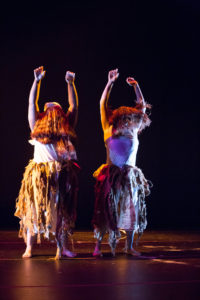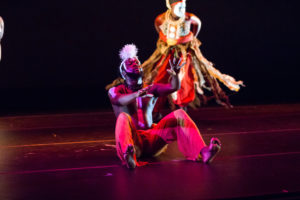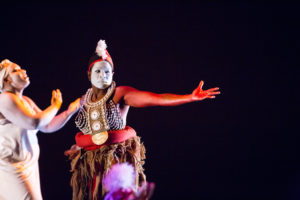 It was unexpectedly and on foreign land that Byb Bibene encountered a nkisi nkondi for the first time. During a visit at the Musée du quai Branly in Paris, where he was on tour in 2006, the Bay Area-based choreographer was taken by the power of a wooden sacred statue, which he learned was a nkisi nkondi (nkisi is loosely translated as ‘medicine’, nkondi as ‘hunter’) and originated from his native land, the Congo. He had never seen nor heard about it back home.
It was unexpectedly and on foreign land that Byb Bibene encountered a nkisi nkondi for the first time. During a visit at the Musée du quai Branly in Paris, where he was on tour in 2006, the Bay Area-based choreographer was taken by the power of a wooden sacred statue, which he learned was a nkisi nkondi (nkisi is loosely translated as ‘medicine’, nkondi as ‘hunter’) and originated from his native land, the Congo. He had never seen nor heard about it back home.
Carved in wood, minkisi (plural of nkisi) were found in the kingdom of Kongo, which was located in West central Africa, in what is now known as northern Angola, Cabinda, the Republic of the Congo, the western portion of the Democratic Republic of the Congo and the southern part of Gabon. The kingdom was mostly an independent state from the 14th to the 19th century, until it was broken apart by colonial Portugal, France and Belgium. Independence was reinstated in the 1960s, although by that time, years of foreign domination had caused devastating damages throughout the Congolese culture, politics and economics.
In pre-colonial time, minkisi were power figures activated by a nganga or healer at the request of an individual, a family or a community to help with public or private matters such as sealing a contract, resolving a conflict, curing a disease or casting off evil spirits. The nganga would activate the nkisi by placing spiritually charged substances inside its hollows, thereby calling the divine spirits to inhabit it and offer their guidance. Minkisi came in various shapes, mainly anthropomorphic or zoomorphic figures, but also vessels or shells. The nkisi nkondi stands out among other minkisi, as one in which the nganga would insert and leave a sharp object – nail, blade, shard – for each request made to the spirits.
Deemed as superstitious ‘fetishes’ by Christian missionaries, minkisi were for the most part destroyed during colonial times. Those that were spared were looted and later reappeared in private collections and museums, primarily in Western Europe and the United States. In addition, by imposing their language and education onto the native populations, colonists systematically eradicated traces of indigenous practices. This is why Bibene, although born and raised in the Republic of the Congo, never knew about minkisi.
An economist by trade – he holds a BA in finance – Bibene only started to pursue dance as a formal study in college: “In Congo dance and music are part of everyday life. I grew up surrounded by traditional ethnic dances, social dances like rumba or ndombolo, as well as American hip-hop. But it was not until I went to college that dance and acting became a big part of my life,” Bibene shared. He started a company in Brazzaville, the country’s capital, and in 2005 it was selected to compete in a dance competition in Paris. He won two prizes and began to travel frequently, mostly in Europe and the United States, where he relocated in 2009.

Encountering the nkisi nkondi in Paris fostered Bibene’s insatiable curiosity and planted the seed for his new work Nkisi Nkondi: Sacred Kongo Sculpture, presented at ODC Theater in May, followed by performances at the Museum of the African Diaspora in June: “I became obsessed and started researching. It took me to revisiting the history and spirituality of my country before colonization.” Bibene began developing the piece two years ago, as part of his thesis for his MFA in Dance at Saint Mary’s College. It started as a duet with Congolese dancer Chris Babingui, before morphing into a quintet. The piece now includes twelve dancers, and live music by Colombian flutist Adriana Rueda as well as music by Bayaka Pygmies and composers Henry Torgue and Serge Houpin.
Featuring text and videos about the creative process and the history of minkisi, the piece recreates some of the dances that might have been used in the process of calling for the divine spirits to inhabit the body of the nkisi nkondi. “I don’t know if there was a specific dance used by the nganga when performing the ritual, but I deducted so because ceremonies always involve dance, music, chanting or clapping. I don’t think that a small matter such as two people sealing a contract with the help of a nganga included dancing, but a larger matter involving the whole community might certainly have,” Bibene commented.
In Nkisi Nkondi, Bibene is not only drawing from the ethnic dances of his country but also from the photos of the minkisi that he came across during his research: “I’m creating from what the minkisi are telling us, from the power emanating from them. In the studio I may ask dancers to choose two of the minkisi’s positions and activate them.” For Bibene this work is an excavation into a cultural heritage that was taken away by colonial powers. “We are remembering history and honoring the spirit of the minkisi. With this piece I’m creating something that is my own internal ritual, connecting with my people’s history, which I didn’t know growing up. There are still a lot of things that I need to learn.”
This process of excavation raises ongoing questions: “What would have happened if people had held on to their beliefs and their healing practices? What if people didn’t embrace Christianity? The people whose heritage minkisi are a part of don’t even know about their existence. Considering that I had to pay a museum entrance fee in Paris to see a nkisi for the first time in my life, what is the economy of this cultural heritage? Do we bring back the statues to where they belong or do we ask for compensation?” Bibene asks. A firm believer that the key to Africa’s advancement rests in the acknowledgment of its indigenous knowledge, author Chika Ezeanya-Esiobu advocates for the return of stolen art to Africa, as a first step in restoring a sense of identity to communities whose traditional practices and history have been partly erased: “It is very important to understand that while Africa’s artwork resident in museums across Europe and America hold mostly aesthetic value in the hands of their current owners, the value it holds for Africans are completely the opposite. Africa’s artifacts hold the collective history and memory of several communities that make up the continent. It represents Africa’s pride in her past, the absence of which has robbed the continent of a clear understanding of its present situation and the will to chart a veritable path to her future,” she stated in an interview with the Danish newspaper Kristeligt Dagblad.

Bibene hopes that his piece encourages audiences to delve into their own history: “I want the audience to realize how important it is to know one’s history. A lot of issues we face in our society come from the fact that people have abandoned practices that were demonized by settlers – different forms of healing or documenting history, for example. I am also hoping to encourage my brothers and sisters in the African American community to connect with their roots.” My conversation with Bibene about Nkisi Nkondi inevitably brings me to consider the colonial history of my own native country. As a white woman originally from France, whose ancestors, and the generations following, if not directly responsible for colonizing Bibene’s land, undisputedly benefited from it, I am confronted with these implications and my own position in regards to the aftermaths of France’s colonial past.
After a two-year hiatus from his bi-annual trips home to complete his MFA, Bibene will return to the Republic of the Congo this summer. He is building a cultural center on the coast, in Pointe-Noire, and continues to oversee the Rue Dance street festival that he co-created in Brazzaville, which is held every two years with international guest artists who come teach and perform. While bridging cultural dialogue through artistic exchange, Bibene hopes to keep on unearthing parts of his people’s heritage and returning them to his community. “For me encountering the nkisi nkondi was the start of a personal revolution, similar to a rebirth. My research and this work have taken me closer to my culture in a way I couldn’t imagine. I started questioning everything, each aspect of my life. It is hard to trace our history, I am only discovering components of it little by little. It will certainly be a lifelong project.”
This article appeared in the May 2018 edition of In Dance.


